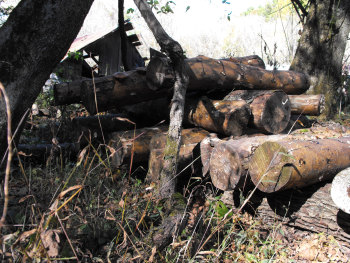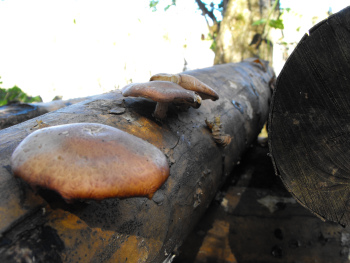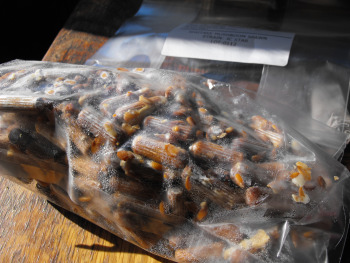
How to Choose Backyard Mushroom Varieties
 When
we started our shiitake logs two years ago, I didn't do my usual
exhaustive research. Some friends were buying plugs and asked us
if we wanted half of the batch, so we simply followed along
in their wake. Luckily, it all worked out, but now we want to
expand our mushroom production and need to put a bit more thought into
it.
When
we started our shiitake logs two years ago, I didn't do my usual
exhaustive research. Some friends were buying plugs and asked us
if we wanted half of the batch, so we simply followed along
in their wake. Luckily, it all worked out, but now we want to
expand our mushroom production and need to put a bit more thought into
it.
The first choice you hit when you enter the world of backyard mushroom
production is species. We tried one of those box kits of button
mushrooms a couple of years ago, with bad results --- our house was too
cold, so we didn't get many, and it only lasted a few weeks.
Since we don't have scads of free straw, wood chips, or manure, for now
we've decided to stick to growing mushrooms in logs. We have
plenty of logs.
 There are two easy species
of log-grown mushrooms --- shiitakes and oysters. Shiitake logs
last longer (3 to 8+ years), but they also take longer before you see
your first fruit (~1 year.) Oyster logs can fruit as soon as six
months after innoculation, but the logs peter out in about two
years. The two species also have to be grown on different kinds
of logs --- oyster mushrooms can be grown on box-elder, which is a
definite plus in our floodplain. I asked Mark whether he'd like
to grow more shiitakes or try oysters. He looked at me as if I
was crazy and said, "Both."
There are two easy species
of log-grown mushrooms --- shiitakes and oysters. Shiitake logs
last longer (3 to 8+ years), but they also take longer before you see
your first fruit (~1 year.) Oyster logs can fruit as soon as six
months after innoculation, but the logs peter out in about two
years. The two species also have to be grown on different kinds
of logs --- oyster mushrooms can be grown on box-elder, which is a
definite plus in our floodplain. I asked Mark whether he'd like
to grow more shiitakes or try oysters. He looked at me as if I
was crazy and said, "Both."
 When we got our last batch of shiitakes,
that's all I knew about them --- that they were shiitakes. But as
I explored the world of mushroom mail order, I discovered there are
three broad categories of shiitakes, and many strains within those
categories. I chose a Wide Range strain (JC Star) which should
fruit all spring, summer, and fall and a Warm Weather Strain (Night
Velvet) which should fill in the gaps by fruiting a lot during hot
summer weather. I skipped the Cold Weather strain (which would
fruit in early spring and late fall) for now since I wanted to be able
to throw in an oyster mushroom variety too and was running out of
cash.
When we got our last batch of shiitakes,
that's all I knew about them --- that they were shiitakes. But as
I explored the world of mushroom mail order, I discovered there are
three broad categories of shiitakes, and many strains within those
categories. I chose a Wide Range strain (JC Star) which should
fruit all spring, summer, and fall and a Warm Weather Strain (Night
Velvet) which should fill in the gaps by fruiting a lot during hot
summer weather. I skipped the Cold Weather strain (which would
fruit in early spring and late fall) for now since I wanted to be able
to throw in an oyster mushroom variety too and was running out of
cash.
Our last choice before I could order was the type of spawn to buy ---
plug, thimble, or sawdust. I have to admit that there I relied
solely on past experience and bought plug. It's possible that
sawdust would have been cheaper per log and faster to fruit, but I went
for easy. And here they are --- our mushroom plugs ready to go in
the log!
| This post is part of our Innoculating Mushroom Logs series.
Read all of the entries: |
Want more in-depth information? Browse through our books.
Or explore more posts by date or by subject.
About us: Anna Hess and Mark Hamilton spent over a decade living self-sufficiently in the mountains of Virginia before moving north to start over from scratch in the foothills of Ohio. They've experimented with permaculture, no-till gardening, trailersteading, home-based microbusinesses and much more, writing about their adventures in both blogs and books.
Want to be notified when new comments are posted on this page? Click on the RSS button after you add a comment to subscribe to the comment feed, or simply check the box beside "email replies to me" while writing your comment.

I'll be talking about how to cut the logs in part two, which I'll probably post tomorrow if nothing more exciting happens. But here are answers to some of your questions which I won't be answering there:
But here are answers to some of your questions which I won't be answering there:
Are you hoping to grow the edible mushrooms in the mulch or just use the shade of the tree to house your mushroom logs? If the latter, you can definitely grow mushrooms under your apple. If the former, I'd have to say that you might not have much luck.
Even though the mulch under your apple trees is wood chips and you can grow some mushrooms on wood chips (oysters more than shiitakes), mulch and mushroom substrate are a bit different. The former should be at least somewhat decomposed, while the latter needs to be fresh. You'd also need to keep the mulch pretty damp to grow mushrooms there, which might be too much moisture for the apple trees. I tried growing King Stropharia mushrooms in fresh wood chip beds just past the mulch zone of my fruit trees last year and even that didn't do well --- I probably would have had to water the mushroom beds a lot to get good yields.
You might be able to grow morels in the earth under the apple trees, but my understanding is that we haven't really figured out how to get morels to fruit consistently yet. We put a few plugs in the ground a year ago and are keeping our fingers crossed, but aren't holding our breath.